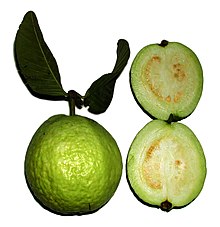bio.wikisort.org - Plant
Psidium guajava, the common guava,[2] yellow guava,[2] lemon guava,[2] or apple guava is an evergreen shrub or small tree native to the Caribbean, Central America and South America.[2] It is easily pollinated by insects; when cultivated, it is pollinated mainly by the common honey bee, Apis mellifera.
| Common guava | |
|---|---|
 | |
| Common guava (Psidium guajava) fruit | |
Conservation status | |
| Scientific classification | |
| Kingdom: | Plantae |
| Clade: | Tracheophytes |
| Clade: | Angiosperms |
| Clade: | Eudicots |
| Clade: | Rosids |
| Order: | Myrtales |
| Family: | Myrtaceae |
| Genus: | Psidium |
| Species: | P. guajava |
| Binomial name | |
| Psidium guajava | |



Overview

Widely cultivated in tropical and subtropical regions around the world, guava fruits can range in size from as small as an apricot to as large as a grapefruit. Various cultivars have white, pink, or red flesh; a few varieties feature red (instead of green or yellow) skin.
When cultivated from seed, guavas are notable for their extremely slow growth rate for several months, before a very rapid acceleration in growth rate takes over. From seed, common guavas may bloom and set fruit in as few as two years or as many as eight. Cuttings, grafting, and air layering are more commonly used as a propagation method in commercial groves. Highly adaptable, guavas can be easily grown as container plants in temperate regions, though their ability to bloom and set fruit is somewhat less predictable. In some tropical locations, guavas can become invasive. It has become a major problem in the Galápagos Islands.[3]
The plant is used in many different shampoo products for its scent. It is also becoming a popular bonsai species and is currently quite popular in India and Eastern Asia.[4]


Chemistry
The leaves of P. guajava contain the flavonol morin, morin-3-O-lyxoside, morin-3-O-arabinoside, quercetin and quercetin-3-O-arabinoside.[5]
Wood
Guava wood from Hawaii is commonly used for the smoking of meat. The wood is resistant to insect and fungal attack. The density of oven-dry wood is about 670 kg/m3 (1,130 lb/cu yd) and has been found suitable for roof trusses in Nigeria.[6]
Traditional medicine
Psidium guajava has been used in traditional medicine by many cultures throughout Central America, the Caribbean, Africa, and Asia.[7] It is used for inflammation, diabetes, hypertension, caries, wounds, pain relief, fever, diarrhea, rheumatism, lung diseases, and ulcers.[7]
Use as food and feed
Guava is an edible fruit, and can be eaten raw or cooked. The processing of the fruits yields by-products that can be fed to livestock. The leaves can also be used as fodder.[8]
References
- Canteiro, C.; Lucas, E. (2019). "Psidium guajava". IUCN Red List of Threatened Species. 2019: e.T49485755A49485759. doi:10.2305/IUCN.UK.2019-1.RLTS.T49485755A49485759.en. Retrieved 19 November 2021.
- "Psidium guajava". Germplasm Resources Information Network (GRIN). Agricultural Research Service (ARS), United States Department of Agriculture (USDA). Retrieved February 6, 2009.
- "Forest of daisy trees in Santa Cruz | Wondermondo". 11 March 2012.
- D'Cruz, Mark. "Ma-Ke Bonsai Care Guide for Psidium guajava". Ma-Ke Bonsai. Retrieved April 22, 2011.
- Bacteriostatic effect of flavonoids isolated from leaves of Psidium guajava on fish pathogens. Rattanachaikunsopon Pongsak and Phumkhachorn Parichat, Fitoterapia, 2007, volume 78, number 6, pages 434-436, INIST:19087798
- E. Lucas; A. Olorunnisola; N. Adewole. "Preliminary Evaluation of Guava (Psidium guajava L.) Tree Branches for Truss Fabrication in Nigeria" (PDF). Retrieved March 25, 2022.
- Gutiérrez, RM; Mitchell, S; Solis, RV (2008). "Psidium guajava: A review of its traditional uses, phytochemistry and pharmacology". Journal of Ethnopharmacology. 117 (1): 1–27. doi:10.1016/j.jep.2008.01.025. PMID 18353572.
- Heuzé V.; Tran G.; Bastianelli D.; Lebas F. (2017). "Guava (Psidium guajava)". Feedipedia.org. Retrieved May 5, 2017.
a programme by INRA, CIRAD, AFZ and FAO
External links
 Media related to Psidium guajava at Wikimedia Commons
Media related to Psidium guajava at Wikimedia Commons Data related to Psidium guajava at Wikispecies
Data related to Psidium guajava at Wikispecies
На других языках
[de] Echte Guave
Die Echte Guave (Psidium guajava), auch Guava, Guayave, Guayaba oder Goiaba genannt, ist eine Pflanzenart aus der Gattung der Guaven (Psidium) in der Familie der Myrtengewächse (Myrtaceae). Sie wird vor allem als Nutz-, aber auch als Medizinalpflanze genutzt.- [en] Psidium guajava
[es] Psidium guajava
El guayabo (palabra de origen arahuaca), arasá o arazá (de origen guaraní),[1] de nombre científico Psidium guajava, es una especie de pequeño árbol perteneciente a la familia de las mirtáceas.[2] Es un arbusto o árbol pequeño natural de América tropical que se ha asilvestrado en otras zonas tropicales del planeta. Se ha convertido en una especie muy habitual en regiones ganaderas del trópico húmedo debido a su facilidad de crecimiento en potreros dedicados para este fin. Su fruto es la guayaba.[fr] Goyavier
Psidium guajava[ru] Гуайява
Гуайя́ва, или гуаява[2], или гойяба[2], или гуава[2] (лат. Psidium guajava) — древесное растение, вид рода Псидиум (Psidium) семейства Миртовые (Myrtaceae). Важная сельскохозяйственная культура. В арабских странах называется "гуафа" или "джуафа".[источник не указан 2097 дней]Другой контент может иметь иную лицензию. Перед использованием материалов сайта WikiSort.org внимательно изучите правила лицензирования конкретных элементов наполнения сайта.
WikiSort.org - проект по пересортировке и дополнению контента Википедии
